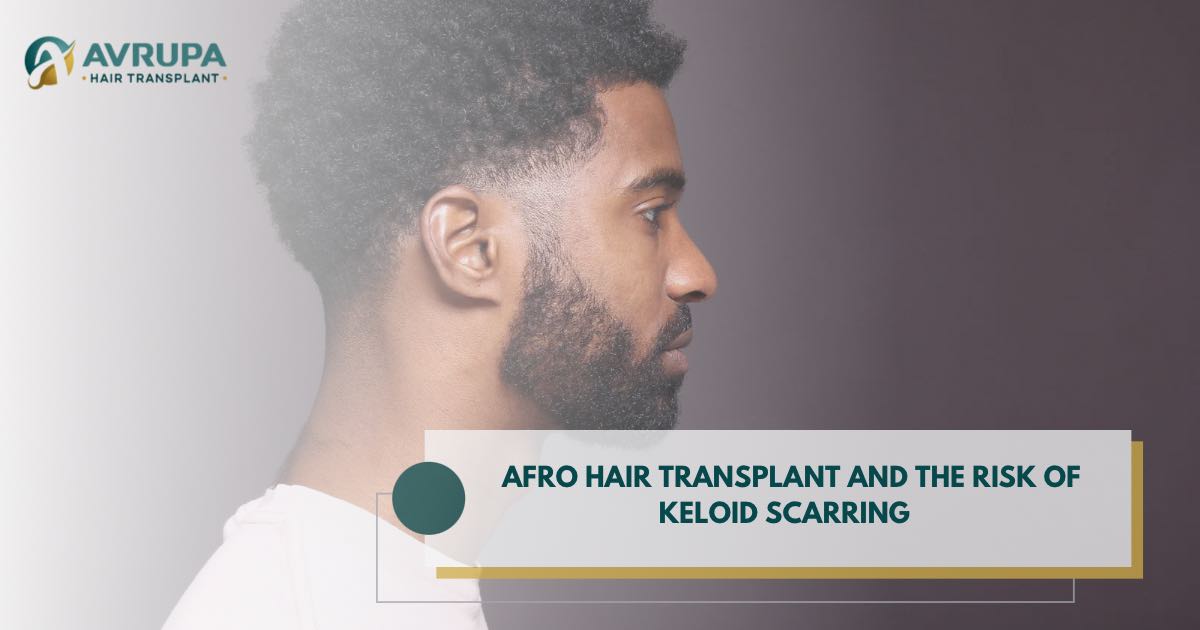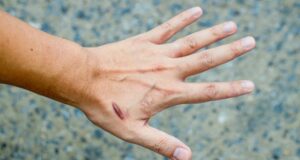
Afro Hair Transplant and Keloid Scarring Risk

September 18, 2025 by
avrupahairtransplant
If you have keloid-prone skin and you’re considering an Afro hair transplant, the goal isn’t just growing hair—it’s growing hair without provoking problem scars. Keloids behave differently from ordinary (hypertrophic) scars: they can extend beyond the original wound, persist, and recur. People of African, Asian, or Hispanic descent are statistically more affected, so careful screening, technique selection, and aftercare matter even more. This guide explains how surgeons assess risk, which steps minimize scarring with FUE/FUT, and the specific aftercare that keeps healing on track.
What are keloids?
Keloids are overgrowths of scar tissue that continue to expand beyond the original wound’s edges after the skin heals—unlike hypertrophic scars, which stay confined to the injury and often flatten with time.

Keloids vs. Hypertrophic Scars
- Keloids overgrow the original wound, may appear weeks to months after injury, and can persist or enlarge.
- Hypertrophic scars stay within the wound borders and tend to improve and flatten with time.
- Keloids are more common in people of African, Asian, or Hispanic descent and in certain body sites; prior keloids increase future risk.
Why This Matters in Afro Hair Transplantation
Historically, linear incisions (FUT) were linked to most reported post-transplant keloids; however, keloids have also been reported after FUE (multiple case reports).
FUE usually leaves micro-punch wounds (fewer millimeters each) and avoids a long linear scar—one reason many keloid-prone patients and surgeons favor FUE—but caution is still required.
Can Keloid-Prone Skin Get an Afro Hair Transplant?
A hair transplant can be done in keloid-prone patients, but only if they can confirm personal/family history and past keloids, consider a test area, prefer low-tension approaches, and use a prevention-first aftercare plan (e.g., silicone for linear incisions, early steroid-based therapy if thickening appears). Keloids after hair transplant are uncommon yet documented—including after FUE—so surgeon selection and follow-up are critical.
Pre-Operative Risk Screening
1) Personal and family history: Any previous keloids (ears, chest, beard area, surgical scars) raise the index of suspicion. Age at onset and body sites matter.
2) Skin and scalp diagnosis: Rule out active scarring alopecia (e.g., CCCA) that could jeopardize native and transplanted hairs. Your dermatologist may advise biopsy if signs point to inflammatory scarring. Hair transplant can be done only once disease is controlled.
3) “Test area” concept: Classic hair-surgery literature describes doing a small test patch/punch grafts near the intended area to observe healing behavior before committing to a large session—especially prudent in those with prior keloids.
4) Technique choice & plan: Discuss FUE vs. FUT. Many keloid-prone patients lean to FUE to avoid a linear incision; however, if FUT is considered, a tension-minimized closure and keloid-prevention protocol are essential.
Keloid-Aware Clinic
If you have a history of keloids, every step of your hair transplant must be adapted—from risk screening and test patches to technique choice and early aftercare. We have built our Black Hair Transplant Turkey program with these safeguards in mind, helping patients with keloid-prone skin achieve natural results while minimizing scar risk.
Evidence-Based Prevention & Treatment Tools (Post-Op)
| Tool | Typical use in keloid care | Notes |
|---|---|---|
| Silicone gel/sheeting | First-line to reduce thickness/color of abnormal scars | Practical for linear closures (FUT) once the incision is closed and intact; less practical for diffuse FUE dots. Evidence supports benefit, though quality varies across studies. |
| Intralesional corticosteroid (e.g., TAC) | First-line for prevention/treatment; can be used alone or with other agents | Often given as a series if thickening appears; reduces fibroblast activity. |
| 5-fluorouracil (5-FU) ± TAC | For resistant or inflamed keloids/hypertrophic scars | Combination TAC+5-FU improves outcomes and can lower steroid side-effects. |
| Pressure / taping | Prevention on earlobes or flat body areas | Limited scalp utility; sometimes used after excisions in other sites. |
| Cryotherapy / lasers | Adjuncts (case-by-case) | Typically combined with steroids; specialist decision. |
| Radiotherapy | Rare adjunct after keloid excision | Considered sparingly due to long-term risks; not routine for hair transplant scars. |
The key is early interception: if a donor line (FUT) or a cluster of FUE dots starts to thicken, itch, or raise, contact your surgeon or dermatologist promptly—earlier steroid-based therapy works better than late rescue.
Aftercare Roadmap for Keloid-Prone Patients
Week 0–2: Calm healing, zero friction
- Follow your clinic’s gentle wash routine; no picking. Avoid occlusive pomades on healing sites.
Week 2–6: Monitor & modulate
- Look for early warning signs (persistent redness, firm ridge, itch, tenderness).
- If any thickening appears, request early evaluation for possible intralesional steroid (± 5-FU) rather than waiting months.
Week 6–12: Protect from tension & occlusion
- Keep styles low-tension, especially at edges; sweat/occlusion under tight hats can aggravate inflammation—rinse after workouts.
- Continue silicone on FUT line if advised; photograph progress monthly to detect changes early.
Long-term (3–12+ months):
- Most hypertrophic tendencies declare themselves early; stay in follow-up. If a lesion stabilizes but remains bulky or symptomatic, your dermatologist may add adjuncts (e.g., cryotherapy + TAC).
FAQs
Can I have a hair transplant if I’ve formed keloids before?
Possibly but with caution. A thorough history, discussion of FUE vs. FUT, and (in some cases) a small test area help predict your response. Expect closer follow-up and a lower threshold for early therapy if thickening appears.
Is FUE “keloid-proof”?
No. FUE reduces linear-scar risk, but reports show rare cases of keloids after FUE. Prevention and fast intervention still matter.
Should I consider radiotherapy to prevent a FUT-line keloid?
Radiotherapy is an occasional adjunct after keloid excision in other areas, but due to risks it’s not routine in hair-transplant care. Discuss risks/benefits with your dermatologist if ever proposed.
Sources:
- Alhamzawi NK. Keloid Scars Arising after Follicular Unit Extraction Hair Transplantation. J Cutan Aesthet Surg. 2020 Jul-Sep;13(3):237-239. doi: 10.4103/JCAS.JCAS_181_19. PMID: 33209003; PMCID: PMC7646428.
- Garg S, Kumar A, Tuknayat A, Thami GP. Extensive Donor Site Keloids in Follicular Unit Extraction Hair Transplantation. Int J Trichology. 2017 Jul-Sep;9(3):127-129. doi: 10.4103/ijt.ijt_54_17. PMID: 28932067; PMCID: PMC5596650.
- Walsh LA, Wu E, Pontes D, Kwan KR, Poondru S, Miller CH, Kundu RV. Keloid treatments: an evidence-based systematic review of recent advances. Syst Rev. 2023 Mar 14;12(1):42. doi: 10.1186/s13643-023-02192-7. PMID: 36918908; PMCID: PMC10012475.
- Shah VV, Aldahan AS, Mlacker S, Alsaidan M, Samarkandy S, Nouri K. 5-Fluorouracil in the Treatment of Keloids and Hypertrophic Scars: A Comprehensive Review of the Literature. Dermatol Ther (Heidelb). 2016 Jun;6(2):169-83. doi: 10.1007/s13555-016-0118-5. Epub 2016 Apr 22. PMID: 27105629; PMCID: PMC4906112.
- Kim SW. Management of keloid scars: noninvasive and invasive treatments. Arch Plast Surg. 2021 Mar;48(2):149-157. doi: 10.5999/aps.2020.01914. Epub 2021 Mar 15. PMID: 33765731; PMCID: PMC8007468.
Written By
avrupahairtransplant
Avrupa Hair Transplant Clinic, Istanbul’s trusted name since 2006, transforms hair restoration with cutting-edge techniques like FUE, DHI, and Sapphire, crafting natural, lasting results. With over 40,000 success stories and a collection of international awards, Avrupa blends innovation with artistry, delivering personalized care that redefines confidence for clients worldwide.